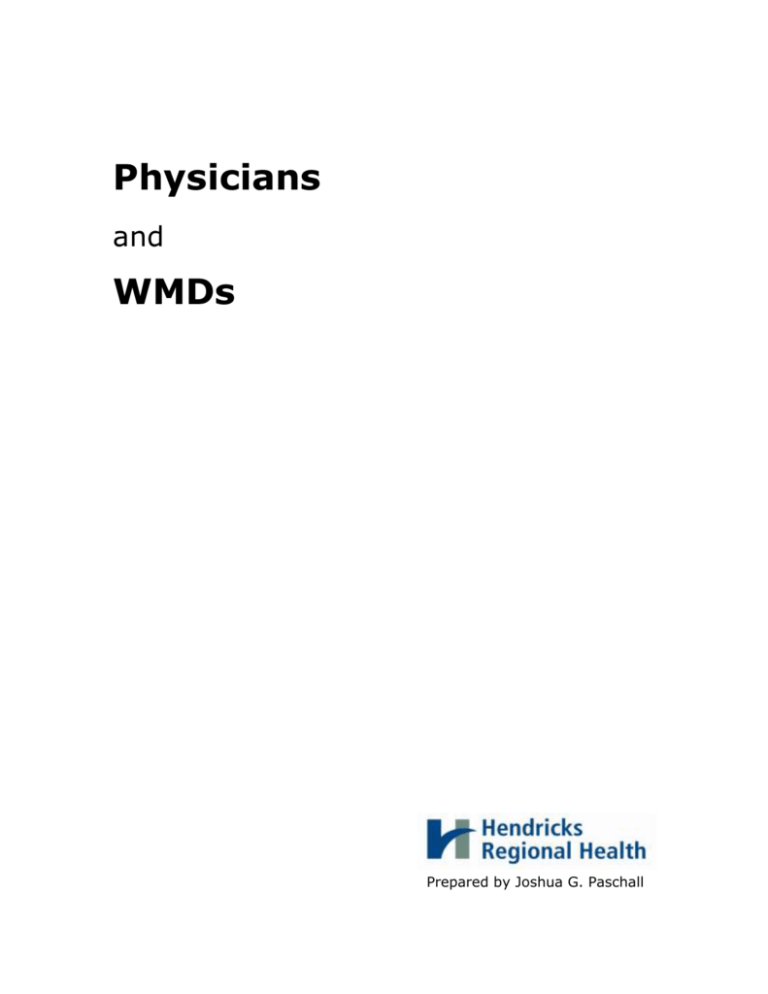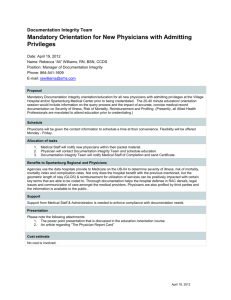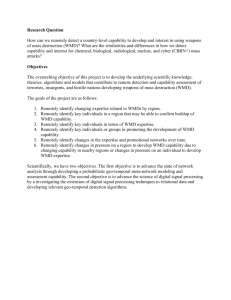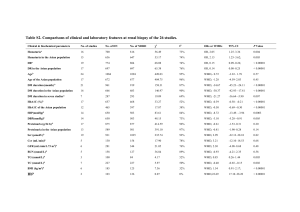Physicians
advertisement

Physicians and WMDs Prepared by Joshua G. Paschall Physicians and WMD “Weapons of mass destruction” (WMD) is a term used to describe a massive weapon with the capacity to indiscriminately kill or incapacitate.1 WMDs can also be described by another acronym, CBRNE (chemical, biological, radiological, nuclear, and explosive), and most commonly refer to non-conventional warheads. Physician preparedness for terrorist events involving WMDs is important. According to an article in Disaster Management Response, “… physicians can play a unique role in public health preparedness because they are among the most trusted first receivers in a health-related incident, including CBRNE-inflicted events. Physicians may assist health officials in dealing with patients who experience fear, confusion, concerns, and psychological stress that normally arise in disasters and that often present significant management and emotional challenges. In addition to providing early detection, treatment, and reporting, physicians can actively report and collaborate with public health authorities to help augment services.” 2 Preparedness is key because a CBRNE event could occur at any time. Each type of WMD attack is unique and will require specific skills, knowledge, as well as an ability to handle the mass casualty challenges that come along with any major disaster (natural or otherwise). The following paragraphs give a brief introduction to each type of WMD and how they can impact physicians. In-depth discussion of these WMDs and preparedness for them can be found in the resources section at the end of this document. Chemical Mass chemical injuries may occur at any time from chemical spills in factories, from tankers, etc., but these may also be a result of WMD attacks. Although hospitals have plans to deal with such a massive influx of victims, it is important that physicians are individually prepared to identify trends that point to a covert release of chemical weapons. Since many early symptoms of chemical attacks may be mild and similar to some common diseases, physicians must be alert to any significant patient trends that might point to a chemical attack. Biological Biological weapons are one of the least common WMDs used by terrorists due to the difficulty in culturing and distributing the various possible pathogens. However, since it has major potential for widespread and self-propagating destruction, a biological attack remains a potent option for terrorist use. In light of the current increased risk for WMD attack, physicians must add possible WMDinflicted diseases into their differential diagnosis of many common flu-like symptoms. In the case of a biological attack, a previously established understanding of common biological agent symptoms may be critical in the early detection and control of disease inflicted by these WMDs. Radiological/Nuclear Radiological and nuclear WMDs provide an entirely unique gamut of problems to deal with. Nuclear WMDs are not likely to be used by terrorists due to their complexity, but radioactive material combined with conventional explosives (a “dirty bomb”) creates a relatively simple and effective method of affecting large populations with lethal or debilitating doses of radioactivity. Physicians can approach 1 Wikipedia, Weapons of Mass Destruction, 5 July 2007, available from http://en.wikipedia.org/wiki/Weapons_of_mass_destruction; Internet; accessed 5 July 2007. 2 Chiehwen Ed Hsu, et al, “Assessing the Readiness and Training Needs of Non-urban Physicians in Public Health Emergency and Response,” Disaster Management and Response, Oct-Dec 2005, 106. both nuclear and radioactive WMD events similarly, although nuclear WMDs will cause a massively larger number of blast casualties than would a “dirty bomb” or some other radiological WMD. Physicians must be aware of the likelihood of delayed symptoms in the case of radiological dosing. Explosives The most common type of WMD due to their ease of use and procurement are explosives. While there is no uncertainty as to the source or impact of these events, the psychological trauma and sudden influx of injuries make them a challenge to deal with. Blast injuries are classified by four mechanisms of injury: primary (blast injury), secondary (flying debris), tertiary (blast wind), and quaternary (all others; e.g., crush injuries or asthma attacks).3 Injury patterns can also vary significantly depending on whether the explosive was high- or low-order, and whether it was manufactured or improvised. Resources An excellent resource from the AMA is the “Management of Public Health Emergencies” CD that is designed to be a quick, easy reference tool that equips physicians to properly identify and handle natural disasters and terrorism events. This informational CD contains over 1,000 links to other useful resources, and it is available for free. Request a copy by contacting the AMA at disastercd@ama-assn.org. Information regarding diverse elements of CBRNE attacks can be found out the following eMedicine website. CME credit is available for all of the nearly fifty different topics. Go to http://www.emedicine.com/emerg/ and click on the “Warfare - Chemical, Biological, Radiological, Nuclear And Explosives” link. Physicians may earn up to 22.5 hours of CME credit through the following resource that focuses on physician preparedness for chemical, biological, or radiological contamination of U.S. water supply systems. This resource also contains a significant amount of linked information to other WMD-preparedness websites. Go to http://www.waterhealthconnection.org/bt/tableofcontents.asp. AMA Quick Reference Guides The following pages contain quick reference guides for radiological, chemical, and biological WMD attacks. These guides were produced by the AMA and are used with permission. They may also be referenced through the AMA website at http://www.ama-assn.org/ 3 Centers for Disease Control, Explosions and Blast Injuries: A Primer for Clinicians, 14 June 2006, available from http://www.bt.cdc.gov/masscasualties/explosions.asp; Internet; accessed 5 July 2007.








